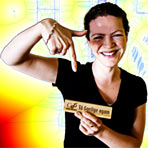Ceachtanna: Long Vowels

 Spelling and speech
Spelling and speech
An important part of the spoken language is that vowels are sometimes pronounced as if they had a síne fada, even though they haven't! So for instance, "barr" is pronounced "bárr", "orlach" is pronounced "órlach", "marla" (plastecine) is pronounced "márla" and so on. The rules behind this are very easy once you get the hang of them.
Remember that a lot of English words have spellings that don't quite match up with the way are spoken either; look at words like "weight", "listen", "business", and... "English"!



 Connacht Irish
Connacht Irish
When the vowels "a" "i" "o" and "u" are followed by the letters "ll", "nn", "m", "rd", "rr" or "rn" then you have to stress them.
You do this by making them sound just like they would with a síne fada
If the vowels "ai" "oi" or "ui" are followed by these letters, put the stress on the "a" the "o" or the "u".



 Munster Irish
Munster Irish
When the vowels "a" "i" "o" and "u" are followed by the letters "ll", "nn", "m", "rd", "rr" or "rn" then you have to stress them.
You do this by making them sound just like they would with a síne fada, except for the vowels "a" and "o", which must be pronounced "au", to rhyme with the word "vowel"
If the vowels "ai" "oi" or "ui" are followed by these letters, put the stress on the "a" the "o" or the "u"
Note that in South-East Munster, e and i fada in words like éist, ím and dínnéar are pronounced to rhyme with "time". Also, u fada sounds (Lúndain) are often pronounced to rhyme with "cow".



 Ulster Irish
Ulster Irish
The rule here is a bit different.
If the vowels "a", "o" or "u" are followed by the letters "rd", "rl" or "rn" then you have to stress them.
You do this by making them sound just like they would with a síne fada
If the vowels "ai" "oi" or "ui" are followed by these letters, put the stress on the "a" the "o" or the "u"
If the vowel "a" is followed by the letters "rr" then you have to stress it. You do this by making it sound just like it would with a síne fada.



 Practise makes perfect
Practise makes perfect
How to learn

Of course, as with any rule, the trick is not so much to learn the rule by heart as to practise examples until it becomes second nature. Children are very good at this. Often, if you learn a few common examples first, the rest start to come to you without thinking. Try the following words, in your own dialect:
am, airde, ard, Baile Mhuirne, ball, barr, beann, Bearna, bord, breall, broim, carn, Carna, cill, Cill Airne, cinn, clann, coll, corn, dall, drom (Munster), droim (Connacht and Ulster), fuinnt, gann, greann, grinn, im, lom, muirnín, Orla, pinnt, poll, Ráth Cairn, An Rinn, roinn, suim, tinn, uirlis.
Once the word is lengthened in any way, though, the long vowel usually disappears. So, you say "ím" but "blas an ime", "cíll" but "cré na cille", "roínn" but "ceann na roinne" and so on.
Some words that don't seem to fit this pattern still follow these rules. "Londain" is pronounced "Lúndain" (or "laundain" in the south-east), "contae" is pronounced "cúndae" (or "caundae" in the south-east) and "ding" (a wedge) is pronounced "díng" (or "die-ng" in the south-east). This is because they used to be spelt with the letter combinations listed above (Lonndain, Conntae, dinng). Although the spellings have changed, the pronounciation hasn't!



Sunday 18th November 2007
 About us
About us Support
Support Locations
Locations Gaeilge
Gaeilge Links
Links